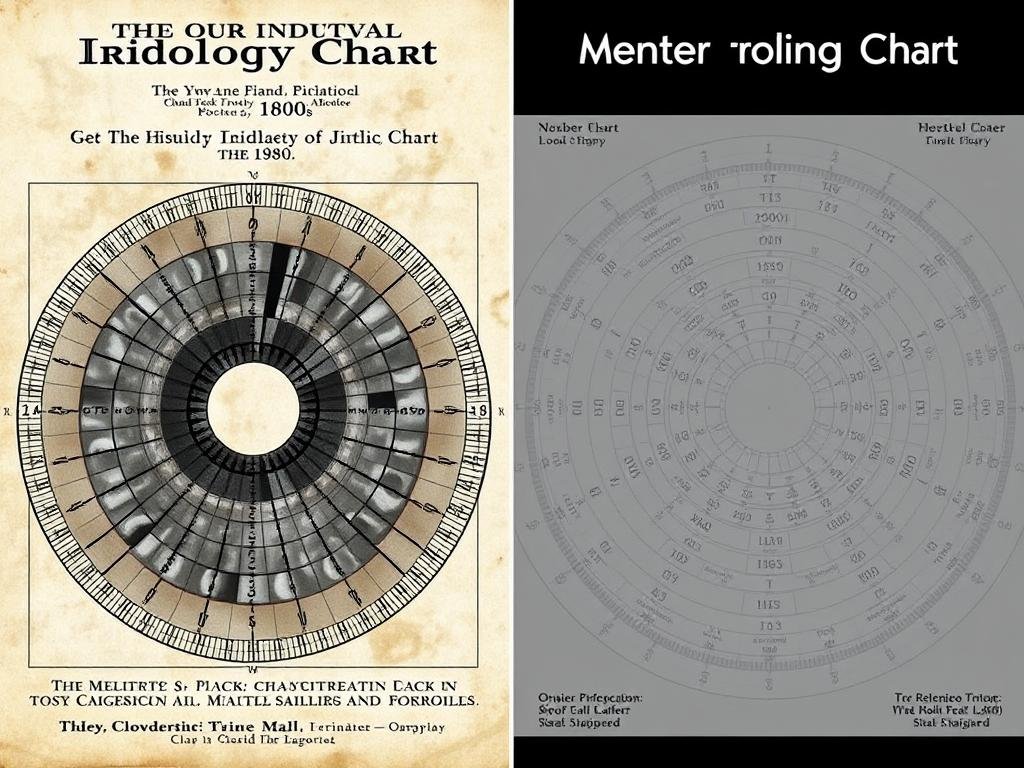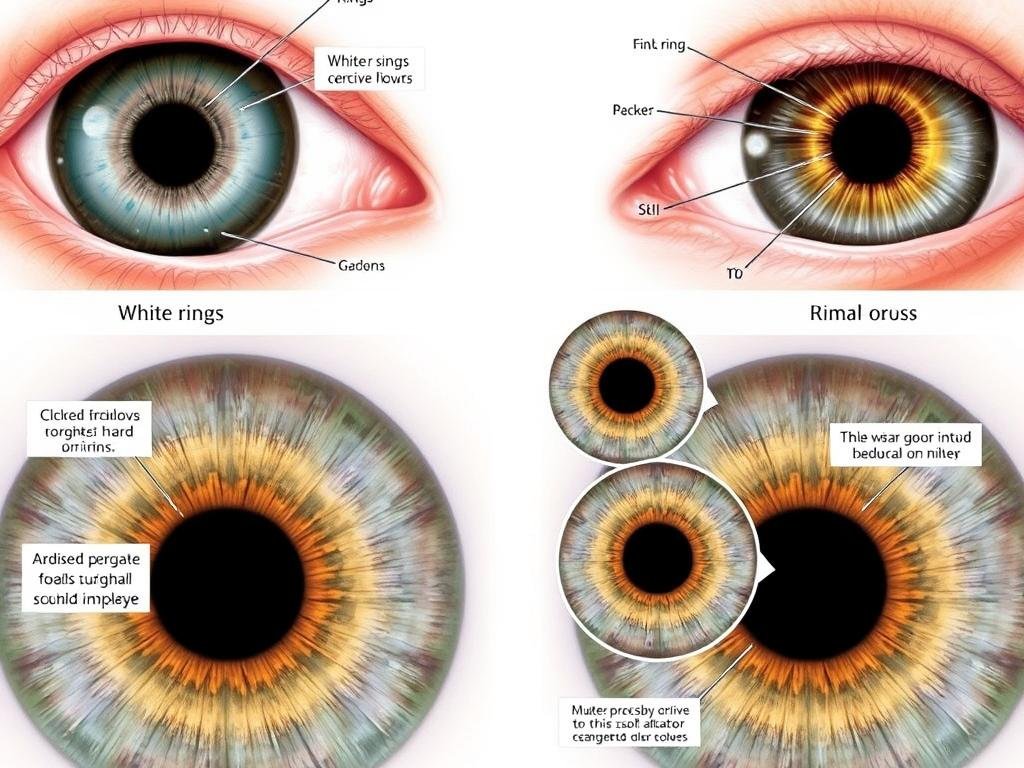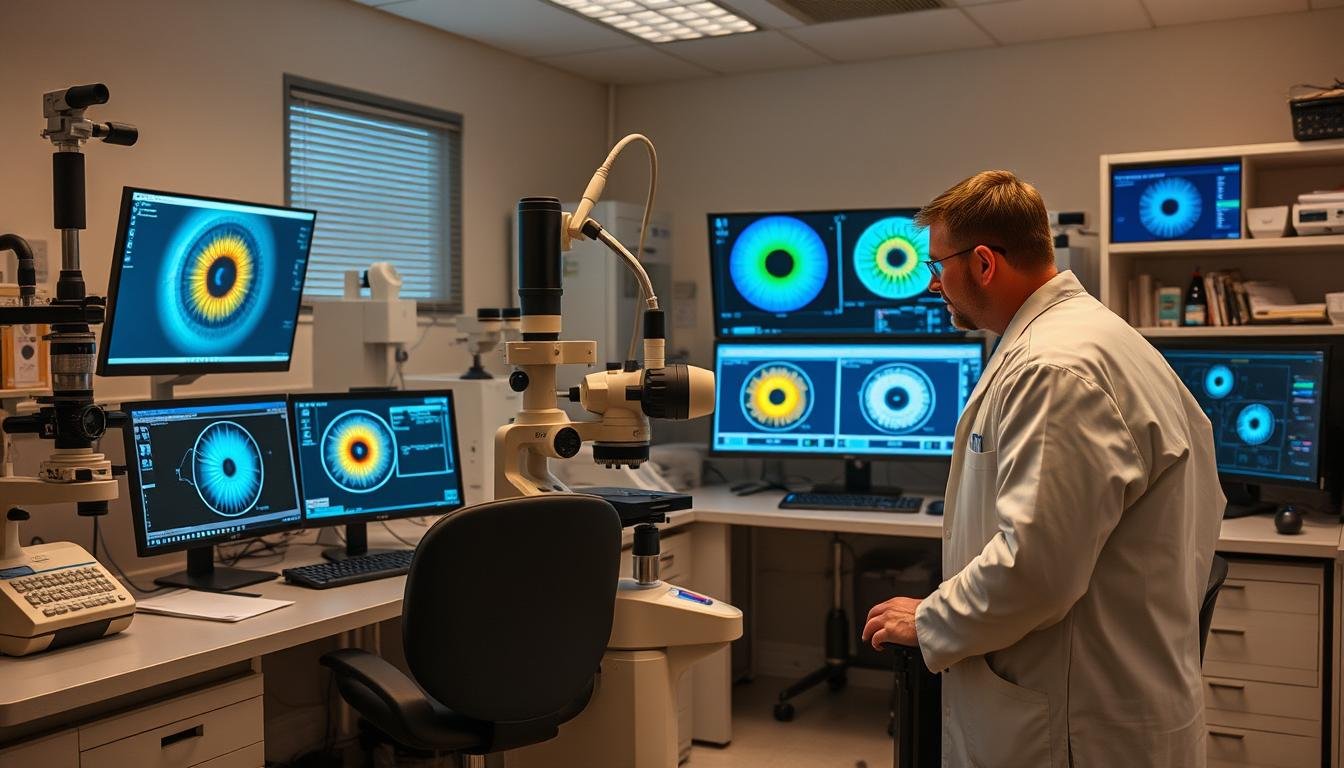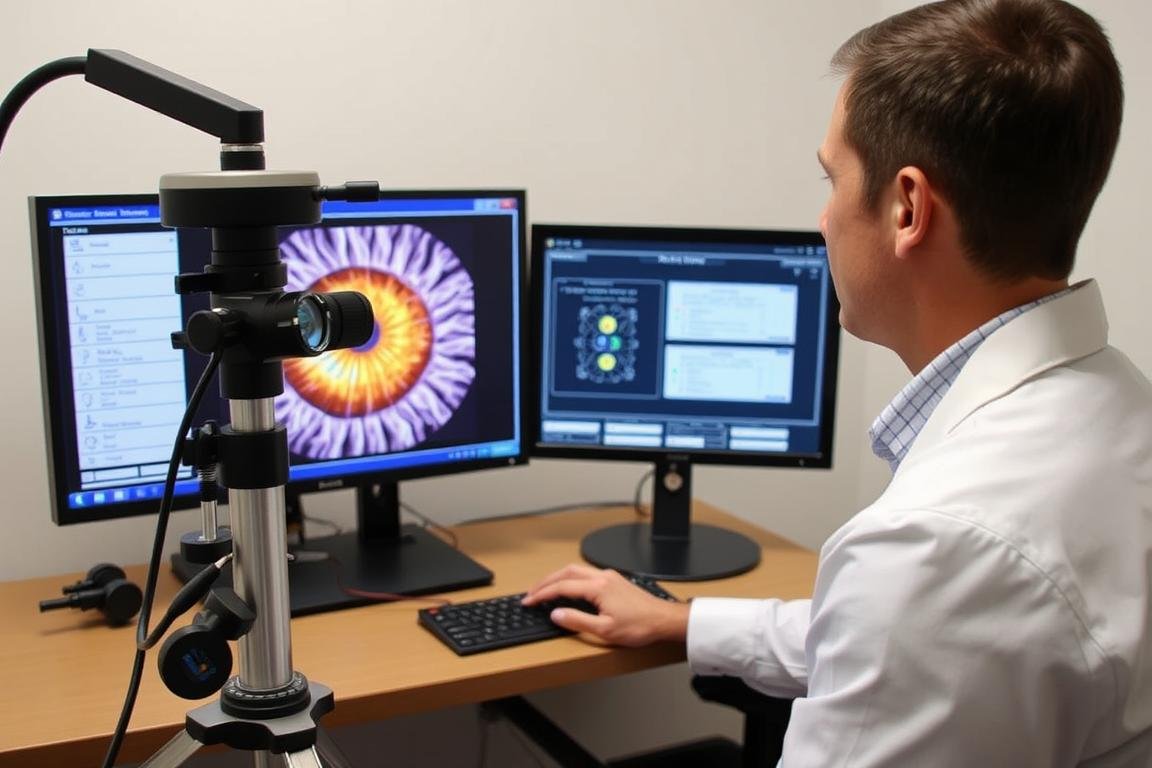El iris, esa parte colorida del ojo, puede contener más información sobre su salud de la que cree. Para los practicantes de la medicina alternativa, el tabla de iridología Sirve como un mapa detallado para interpretar los patrones, colores y marcas de su iris. Esta fascinante herramienta de diagnóstico divide el iris en zonas que corresponden a diferentes órganos y sistemas de todo el cuerpo. Ya sea que tenga curiosidad acerca de las prácticas de salud alternativas o busque comprender lo que podrían significar esos patrones únicos en sus ojos, esta guía completa lo guiará a través de todo lo que necesita saber sobre gráficos de iridología y su interpretación.

Un completo tabla de iridología mapeo del iris a varios órganos y sistemas corporales
¿Qué es un Tabla de iridología?
Un tabla de iridología es una herramienta de diagnóstico utilizada por los iridólogos para mapear diferentes áreas del iris con los órganos y sistemas correspondientes del cuerpo. Estos cuadros sirven como guías de referencia que ayudan a los profesionales a identificar posibles problemas de salud al examinar cambios, marcas o decoloraciones en regiones específicas del iris. La práctica de la iridología se basa en la teoría de que el iris contiene un mapa completo del cuerpo, y cada sección refleja la condición de un órgano o parte del cuerpo específico.
El concepto de iridología se remonta al siglo XVII, pero fue el Dr. Ignatz von Peczely, un médico húngaro, quien desarrolló el primer estudio integral. tabla de iridología en el siglo XIX. Según la historia, notó cambios en el iris de un búho después de que el pájaro sufriera una fractura en una pata, lo que lo inspiró a estudiar la conexión entre los patrones del iris y la salud física. Lo moderno de hoy gráficos de iridología han evolucionado notablemente pero mantienen el mismo principio fundamental: el iris refleja el estado de salud de todo el cuerpo.

la evolución de gráficos de iridología desde mapas históricos dibujados a mano hasta versiones digitales modernas
Comprender las zonas de un Tabla de iridología
El tabla de iridología Divide el iris en múltiples zonas, cada una correspondiente a diferentes partes del cuerpo. Estas zonas están dispuestas en un patrón radial, similar a la esfera de un reloj, con la pupila en el centro. El gráfico normalmente distingue entre el iris derecho e izquierdo, ya que a menudo representan lados o aspectos diferentes del cuerpo.
Mapeo del iris derecho en el Tabla de iridología

Gráfico de iridología ojo izquierdo - Gráfico de iridología - Ojo izquierdo
ojo izquierdo reflejes lado izquierdo cuerpo.
| Posición del reloj (ojo izquierdo) | Corresponde órgano/sistema | Detalles |
|---|
| 1 en punto - 2 en punto | Cuello izquierdo
| Corresponde a los órganos reproductivos derecho, incluyen útero, ovarios (hembras) o testículos (macho). |
| 2 en punto - 3 en punto | Pulmón izquierdo | Ringflects Health Right Junks, incluyen rodillas, caderas, codos y hombros. |
| 3 en punto - 4 en punto | Tórax izquierdo | Corresponde a la columna vertebral, la salud espinal, la alineación y la flexibilidad en el lado derecho. |
| 4 en punto - 5 en punto | Abdomen de la parte superior izquierda
| Ringflects Bladder y Sistema urinario del lado izquierdo. |
| 5 en punto - 6 en punto | Abdomen inferior izquierdo
| Anillo de anillo de colon derecho, intestino delgado y salud digestiva. |
| 6 en punto - 7 en punto | Pélvico izquierdo
| Ringflects riñón derecho, se centra en la filtración, la desintoxicación y el equilibrio de fluidos. |
| 7 en punto - 8 en punto | Izquierda hacia atrás
| Ringflects estómago y órganos digestivos en el lado derecho. |
| 8 en punto - 9 en punto | Izquierda de la parte superior de la espalda
| Corresponde al hígado del lado derecho, la desintoxicación responsable y la producción de bilis. |
| 9 en punto - 10 en punto | Garganta izquierda
| Antes de anillo del corazón del lado derecho, afectan la salud y la circulación cardiovascular. |
| 10 en punto - 11 en punto | Cara izquierda | Ringflects pulmón derecho, salud respiratoria y función Brea. |
| 11 en punto - 12 en punto | Cerebro izquierdo | Corresponde al cerebro del hemisferio derecho, la salud mental y las funciones cognitivas. |
| 12 en punto - 1 en punto | Cerebro izquierdo | Corresponde al cerebro del hemisferio derecho, la salud mental y las funciones cognitivas. |
- Ojo derecho: Ringflects Lado derecho cuerpo (por ejemplo, Bien riñón, Bien pulmón, Bien órganos reproductivos, etc.).
Mapeo del iris izquierdo en el Tabla de iridología

Gráfico de iridología Ojo derecho -Iridología Tabla -Ojo derecho
ojo derecho reflejes lado derecho cuerpo.
| Posición del reloj (ojo derecho) | Corresponde órgano/sistema | Detalles |
|---|
| 1 en punto - 2 en punto | Cara derecha | Corresponde a los órganos reproductivos izquierdos, incluyen útero, ovarios (hembras) o testículos (hombres). |
| 2 en punto - 3 en punto | Garganta
| Ringflects Health Juntas izquierdas, incluye rodillas, caderas, codos y hombros. |
| 3 en punto - 4 en punto | Espalda superior derecha
| Corresponde a la columna vertebral, la salud espinal, la alineación y la flexibilidad. |
| 4 en punto - 5 en punto | Vejiga | Ringflects Bladder y Sistema urinario del lado derecho. |
| 5 en punto - 6 en punto | Pélvico derecho | Anlingpresents izquierda colon, intestino delgado y salud digestiva. |
| 6 en punto - 7 en punto | Abdomen inferior derecha
| Ringflects izquierdo de riñón, se centra en la filtración, la desintoxicación y el equilibrio de fluidos. |
| 7 en punto - 8 en punto | Abdomen superior derecho
| Ringflects estómago y órganos digestivos en el lado izquierdo. |
| 8 en punto - 9 en punto | Tórax derecho | Corresponde al hígado del lado izquierdo, la desintoxicación responsable y la producción de bilis. |
| 9 en punto - 10 en punto | Pulmón derecho | Los ritmo del corazón del lado izquierdo, afectan la salud y la circulación cardiovascular. |
| 10 en punto - 11 en punto | Cuello derecho | Ringflects Left Lunm, salud respiratoria y función Brea. |
| 11 en punto - 12 en punto | Cerebro derecho
| Corresponde al cerebro del hemisferio izquierdo, la salud mental y las funciones cognitivas. |
| 12 en punto - 1 en punto | Cerebro derecho
| Corresponde al cerebro del hemisferio izquierdo, la salud mental y las funciones cognitivas. |
Desglose detallado de zonas de un tabla de iridología mostrando correspondencias de órganos específicos
Interpretación de las marcas del iris en un Tabla de iridología
Más allá del mapeo zonal, los iridólogos analizan marcas, colores y patrones específicos dentro del iris. Estas características se cruzan con las tabla de iridología para identificar posibles problemas de salud. A continuación se muestran algunas marcas comunes del iris y sus interpretaciones según la iridología:
Variaciones de color
- Iris azul o claro – A menudo asociado con la constitución linfática, puede indicar sensibilidad a problemas digestivos.
- Iris marrón u oscuro – A menudo relacionado con la constitución hematogénica, puede sugerir funciones hepáticas y digestivas más fuertes.
- Colores mezclados – Puede indicar un tipo constitucional mixto con variadas tendencias de salud.
Señales Estructurales
- Surcos radiales – Las líneas que se extienden desde la pupila hacia afuera pueden indicar predisposiciones genéticas.
- Lagunas – Áreas cerradas y oscuras que pueden sugerir debilidades de órganos.
- Criptas – Depresiones en forma de hoyos que pueden indicar fortalezas o debilidades inherentes.
Marcas comunes y sus significados
- Anillos blancos (anillo de sodio) – Un anillo blanco alrededor del borde exterior del iris puede indicar desequilibrios minerales o presión arterial alta.
- Manchas oscuras – Puede sugerir acumulación de toxinas o daño en el órgano correspondiente.
- Rayas blancas – A menudo se interpreta como inflamación o irritación en el área del cuerpo relacionada.
- Tintes amarillos – Puede indicar estrés renal o hepático.

Marcas comunes del iris y sus interpretaciones según gráficos de iridología
Descargue su tabla de iridología completa y gratuita
Obtenga acceso instantáneo a nuestra alta resolución tabla de iridología con mapeos de zonas detallados y una guía para principiantes sobre la interpretación del iris. Perfecto para estudiantes de salud alternativa o cualquier persona que tenga curiosidad por saber qué podrían revelar sus ojos.
Descargar la lista de iridología gratuita
Tipos constitucionales en Gráficos de iridología
Los iridólogos suelen clasificar a las personas en diferentes tipos constitucionales según las características predominantes de su iris. Estos tipos constitucionales, tal como se representan en gráficos de iridología, se cree que indican fortalezas y debilidades inherentes al perfil de salud de una persona.
Tipo linfático
Caracterizado por iris azules o de colores claros. Según la iridología, estas personas pueden tener sistemas linfáticos más fuertes, pero pueden ser más susceptibles a problemas respiratorios y digestivos.
Tipo hematogénico
Identificado por iris marrones o más oscuros. Se cree que estos individuos tienen sistemas circulatorios y función hepática más fuertes, pero pueden ser más propensos a sufrir afecciones inflamatorias.
Tipo mixto
Presenta una combinación de colores y patrones. Este tipo sugiere una combinación de características de diferentes tipos constitucionales, con fortalezas variadas y posibles problemas de salud.

Los tres tipos constitucionales principales representados en gráficos de iridología
Perspectiva científica sobre Gráficos de iridología
Mientras gráficos de iridología se utilizan ampliamente en la medicina alternativa, es importante comprender la perspectiva de la comunidad científica sobre esta práctica. La medicina convencional tiene una visión diferente sobre la validez y confiabilidad de la iridología como herramienta de diagnóstico.
Proponentes’ Vista
- El iris contiene miles de terminaciones nerviosas conectadas al cerebro
- Los cambios en los tejidos corporales podrían reflejarse en el tejido del iris a través de conexiones neurológicas
- La evidencia anecdótica sugiere evaluaciones de salud exitosas a través de la iridología
- Puede servir como herramienta complementaria junto con otros métodos de diagnóstico.
Preocupaciones científicas
- Investigación limitada revisada por pares que respalda las afirmaciones diagnósticas
- Los estudios controlados no han validado consistentemente la efectividad de la iridología
- Falta de estandarización entre diferentes gráficos de iridología y sistemas
- Posibilidad de retraso en el diagnóstico médico adecuado si se confía exclusivamente en él
Varios estudios clínicos han examinado la eficacia de la iridología. Un notable estudio publicado en el Journal of the American Medical Association puso a prueba la capacidad de los iridólogos para detectar enfermedades de la vesícula biliar mediante el examen del iris. Los resultados mostraron que la iridología no fue efectiva en el diagnóstico de esta condición. Sin embargo, sus defensores argumentan que la iridología es más adecuada para identificar tendencias y predisposiciones que para diagnosticar enfermedades específicas.

Investigación científica que examina la validez de gráficos de iridología y afirmaciones diagnósticas
Aplicaciones prácticas de Gráficos de iridología
A pesar del debate en curso sobre su validez científica, muchos profesionales e individuos encuentran valioso el uso gráficos de iridología como parte de un enfoque holístico de salud. A continuación se muestran algunas formas prácticas en que se aplican estos gráficos:
Cómo lo utilizan los profesionales Gráficos de iridología
- Evaluación de salud – Identificar áreas potenciales de debilidad o estrés en el cuerpo.
- Orientación preventiva – Sugerir modificaciones en el estilo de vida basadas en tendencias constitucionales.
- Análisis complementario – Usar junto con otras herramientas de diagnóstico para formar una imagen de salud más completa.
- Seguimiento de cambios – Monitorear los cambios del iris a lo largo del tiempo para evaluar mejoras o deterioros.
Herramientas y tecnología
La iridología moderna ha evolucionado para incorporar tecnología avanzada:
- Iriscopios – Cámaras especializadas que capturan imágenes de alta resolución del iris.
- Software de análisis digital – Programas que ayudan a analizar patrones de iris y compararlos con gráficos de iridología
- Aplicaciones móviles – Aplicaciones para teléfonos inteligentes que permiten el análisis básico del iris mediante cámaras de teléfonos
- Cartas Electrónicas – Versiones digitales de gráficos de iridología con funciones interactivas

La tecnología moderna se combina con la tradicional. gráficos de iridología para un análisis más preciso
Empezando con Gráficos de iridología
Si está interesado en explorar la iridología por sí mismo, aquí hay algunos pasos para comenzar:
- Edúquese – Aprende los conceptos básicos de gráficos de iridología e interpretación del iris a través de libros, cursos o recursos en línea
- Encuentre un gráfico confiable – Compra o descarga un detallado tabla de iridología de una fuente confiable
- Obtenga las herramientas adecuadas – Como mínimo, necesitarás una lupa; Lo ideal es una cámara de iris especializada o un accesorio para su teléfono inteligente.
- Consulta con Profesionales – Considere visitar a un iridólogo capacitado para su primera evaluación.
- Mantener registros – Tome fotografías de sus iris periódicamente para realizar un seguimiento de cualquier cambio.
Consejos para el autoexamen
Si bien se recomienda la consulta profesional, puedes realizar un autoexamen básico:
- Utilice luz natural o una fuente de luz blanca brillante.
- Párese cerca de un espejo o use un espejo de aumento.
- Compara lo que ves con un estándar tabla de iridología
- Busque marcas, colores y patrones obvios.
- Recuerda que el autodiagnóstico nunca debe sustituir el consejo médico profesional

Configuración básica para el autoexamen utilizando un tabla de iridología en casa
Explore el mundo del análisis holístico de la salud
Profundice su comprensión de la iridología y otros métodos naturales de evaluación de la salud con nuestros recursos integrales. Únase a miles de entusiastas de la salud que han descubierto nuevos conocimientos sobre su bienestar.
Descargue su guía gratuita de iridología
Pensamientos finales sobre Gráficos de iridología
El tabla de iridología representa una fascinante intersección de sabiduría antigua y prácticas de salud alternativas. Si bien la validación científica sigue siendo limitada, muchos encuentran valor en este enfoque holístico para comprender las posibles fortalezas y debilidades del cuerpo. Ya sea que adopte la iridología como una herramienta de salud complementaria o la aborde con un sano escepticismo, el estudio de los patrones del iris ofrece una perspectiva intrigante sobre la conexión entre las diferentes partes de nuestro cuerpo.
Como ocurre con cualquier práctica de salud, es importante mantener un enfoque equilibrado. Cartas de iridología pueden proporcionar ideas interesantes, pero deberían complementar, en lugar de reemplazar, la atención médica convencional. Al comprender tanto las posibilidades como las limitaciones de la iridología, podrá tomar decisiones informadas sobre la incorporación de esta práctica en su camino hacia la salud.

Integrando tabla de iridología análisis en una consulta de salud integral












